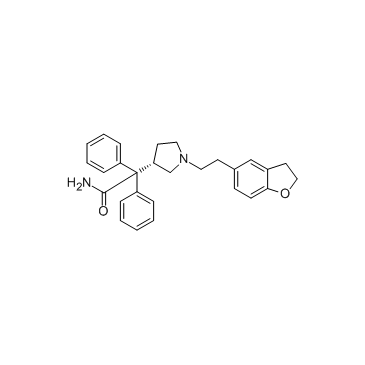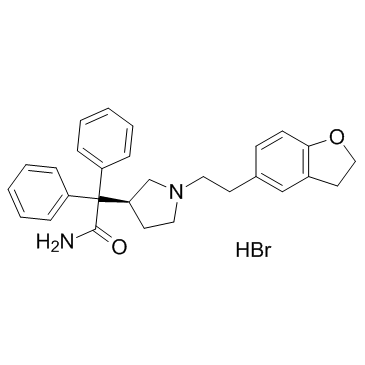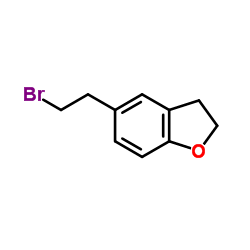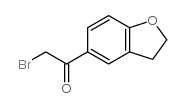Darifenacin
Modify Date: 2025-08-24 11:07:06

Darifenacin structure
|
Common Name | Darifenacin | ||
|---|---|---|---|---|
| CAS Number | 133099-04-4 | Molecular Weight | 426.550 | |
| Density | 1.2±0.1 g/cm3 | Boiling Point | 614.3±55.0 °C at 760 mmHg | |
| Molecular Formula | C28H30N2O2 | Melting Point | N/A | |
| MSDS | N/A | Flash Point | 325.3±31.5 °C | |
Use of DarifenacinDarifenacin(UK88525) is a selective M3 muscarinic receptor antagonist with pKi of 8.9.IC50 value: 8.9 (pKi) [1]Target: M3 receptorin vitro: Darifenacin exerts non-parallel rightward displacement of the agonist curve and also significant depression of the maximum response (+)-cis-Dioxolane produced concentration-dependent contraction of the isolated bladder of rat [1]. Darifenacin produces a concentration dependent increase in R123 (P-gp probe) accumulation in MDCK cells. Darifenacin stimulates ATPase activity in P-gp membrane in a clear concentration dependent response manner with an estimated ED50 value of 1.6 μM. Darifenacin (100 nM) shows a significantly greater permeability for darifenacin in the basolateral to apical direction resulting in an efflux ratio in BBMEC monolayers of approximately 2.6 [2].in vivo: Darifenacin produces dose-dependent inhibition of amplitude of volume-induced bladder contractions(VIBCAMP), producing 35% inhibition at dose of 283.3 nmol/kg and maximal inhibition of approximately 50–55% [1]. Darifenacin (0.1 mg/kg i.v.) reduces bladder afferent activity in both Aδ and C fibers in female Sprague-Dawley rats, the decrease in afferent spikes in C fibers may be more pronounced than that in Aδ fibers [3]. |
| Name | darifenacin |
|---|---|
| Synonym | More Synonyms |
| Description | Darifenacin(UK88525) is a selective M3 muscarinic receptor antagonist with pKi of 8.9.IC50 value: 8.9 (pKi) [1]Target: M3 receptorin vitro: Darifenacin exerts non-parallel rightward displacement of the agonist curve and also significant depression of the maximum response (+)-cis-Dioxolane produced concentration-dependent contraction of the isolated bladder of rat [1]. Darifenacin produces a concentration dependent increase in R123 (P-gp probe) accumulation in MDCK cells. Darifenacin stimulates ATPase activity in P-gp membrane in a clear concentration dependent response manner with an estimated ED50 value of 1.6 μM. Darifenacin (100 nM) shows a significantly greater permeability for darifenacin in the basolateral to apical direction resulting in an efflux ratio in BBMEC monolayers of approximately 2.6 [2].in vivo: Darifenacin produces dose-dependent inhibition of amplitude of volume-induced bladder contractions(VIBCAMP), producing 35% inhibition at dose of 283.3 nmol/kg and maximal inhibition of approximately 50–55% [1]. Darifenacin (0.1 mg/kg i.v.) reduces bladder afferent activity in both Aδ and C fibers in female Sprague-Dawley rats, the decrease in afferent spikes in C fibers may be more pronounced than that in Aδ fibers [3]. |
|---|---|
| Related Catalog | |
| References |
| Density | 1.2±0.1 g/cm3 |
|---|---|
| Boiling Point | 614.3±55.0 °C at 760 mmHg |
| Molecular Formula | C28H30N2O2 |
| Molecular Weight | 426.550 |
| Flash Point | 325.3±31.5 °C |
| Exact Mass | 426.230713 |
| PSA | 55.56000 |
| LogP | 4.50 |
| Vapour Pressure | 0.0±1.8 mmHg at 25°C |
| Index of Refraction | 1.624 |
| InChIKey | HXGBXQDTNZMWGS-RUZDIDTESA-N |
| SMILES | NC(=O)C(c1ccccc1)(c1ccccc1)C1CCN(CCc2ccc3c(c2)CCO3)C1 |
| Storage condition | 2-8℃ |
| Precursor 9 | |
|---|---|
| DownStream 1 | |
| 2-(1-(2-(2,3-Dihydrobenzofuran-5-yl)ethyl)pyrrolidin-3-yl)-2,2-diphenylacetamide |
| 3-Pyrrolidineacetamide, 1-[2-(2,3-dihydro-5-benzofuranyl)ethyl]-α,α-diphenyl-, (3S)- |
| 2-{(3S)-1-[2-(2,3-Dihydro-1-benzofuran-5-yl)ethyl]-3-pyrrolidinyl}-2,2-diphenylacetamide |
| (S)-1-(2-(2,3-Dihydro-5-benzofuranyl)ethyl)-α,α-diphenyl-3-pyrrolidineacetamide |
| 2-{(3S)-1-[2-(2,3-Dihydro-1-benzofuran-5-yl)ethyl]pyrrolidin-3-yl}-2,2-diphenylacetamide |
| Darifenacin |
| (S)-1-(2-(2,3-Dihydro-5-benzofuranyl)ethyl)-a,a-diphenyl-3-pyrrolidineacetamide |
| 2-((3S)-1-(2-(2,3-Dihydro-1-benzofuran-5-yl)ethyl)-3-pyrrolidinyl)-2,2-diphenylacetamide |
![(S)-2-{1-[2-(benzofuran-5-yl)ethyl]-3-pyrrolidinyl}-2,2-diphenylacetamide Structure](https://image.chemsrc.com/caspic/454/133033-99-5.png) CAS#:133033-99-5
CAS#:133033-99-5 CAS#:133099-07-7
CAS#:133099-07-7 CAS#:127264-14-6
CAS#:127264-14-6 CAS#:134002-25-8
CAS#:134002-25-8![2,2-diphenyl-2-{(S)-1-[2-(2,3-dihydro-benzofuran-5-yl)-ethyl]-pyrrolidin-3-yl}-acetic acid methyl ester Structure](https://image.chemsrc.com/caspic/345/1072227-73-6.png) CAS#:1072227-73-6
CAS#:1072227-73-6![(S)-2,2-diphenyl-2-[1-(tert-butyloxycarbonyl)-3-pyrrolidinyl]acetonitrile Structure](https://image.chemsrc.com/caspic/104/1189753-52-3.png) CAS#:1189753-52-3
CAS#:1189753-52-3![2,2-Diphenyl-2-[(3S)-3-pyrrolidinyl]acetamide Structure](https://image.chemsrc.com/caspic/132/133099-11-3.png) CAS#:133099-11-3
CAS#:133099-11-3 CAS#:90843-31-5
CAS#:90843-31-5 CAS#:151427-19-9
CAS#:151427-19-9